Guest TR by Jeff Welch, originally posted on 14erskiers.com and Jeff’s website, adrenalated.com.
At 12:30am, my alarm buzzed, pulling me from what could be described as “sleep” in only the most generous of terms. I had been drifting halfway between consciousness and unconsciousness, a mixture of exhaustion, anticipation, excitement, nervousness, and discomfort preventing either one from fully taking hold. As I blearily struggled to align and insert my contacts, a white light appeared from around the corner, accompanied by voices.
Rick stirred. “Walkers!” he mumbled dramatically, as if they were zombies coming for us in the middle of the night. While slogging 6 miles up a groomed road in the dark when God gave us snowmobiles sounds like the sort of thing that zombies would do, we quickly established that these Walkers were merely winter climbers gunning for South Maroon Peak.
Four hours earlier, we pulled up to winter closure on Maroon Creek Road at the T-Lazy 7 Ranch. While talking briefly with one of Ben’s friends we happened upon in the parking lot, a bearded dude suddenly arose from the bed of his pickup truck, surprising us as he stated that he would be leaving at 10pm to try Maroon Peak, hence why he was trying to sleep. I apologized in advance for the disturbance I was about to create, then we fired up the sleds and shuttled ourselves and bivy supplies up to the summer trailhead at Maroon Lake. Rick and I left Ben to consume the can of Coors that didn’t survive the ride, then shuttled one sled down to East Maroon Portal before returning to Maroon Lake on the other sled. We made quick work of the remaining Coors and a couple sandwiches then crawled into cocoons of down and nylon, shutting our eyes in a feeble attempt to regain strength and energy in preparation for the day to come.
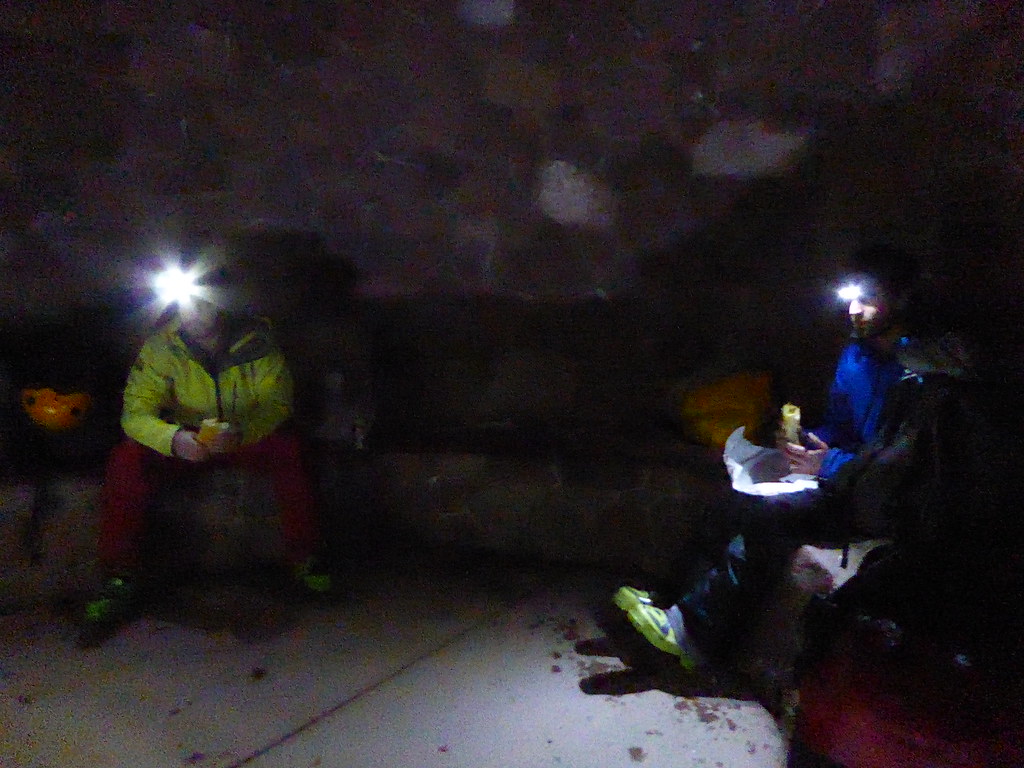
Once we established the Walkers were there to climb mountains and not dine on our brains, we quickly saddled up and were skinning up the summer trail by 1 am. We’ve had several groups of friends encounter navigational difficulties getting from the summer trail up into the large amphitheater below Pyramid’s dramatic north face, so we researched the route thoroughly, referencing past trip reports, Caltopo, satellite imagery, and Google Earth.
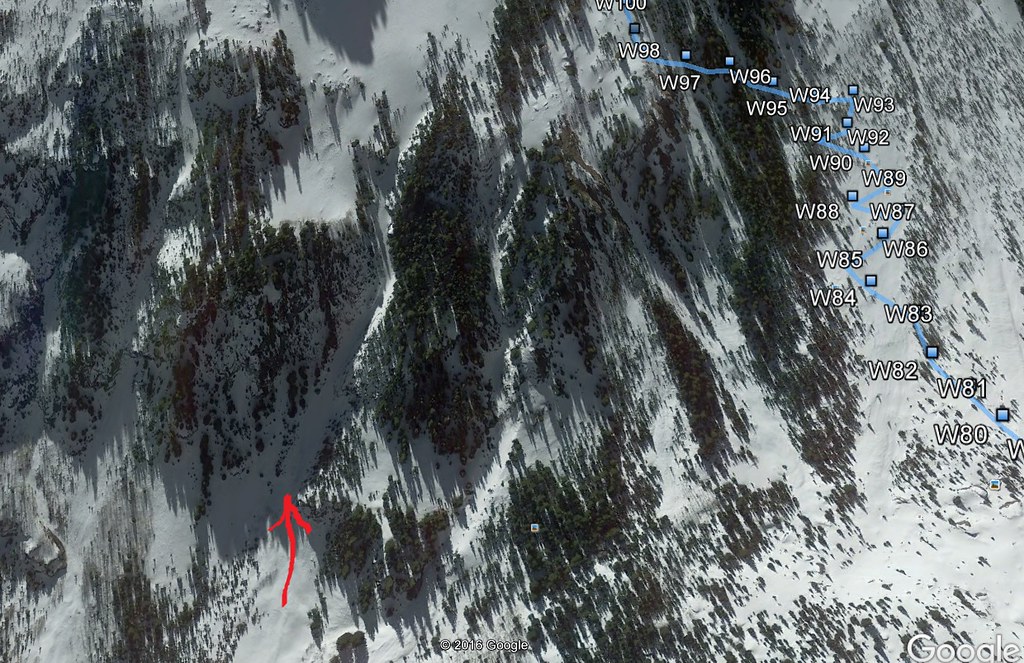
We programmed the summer trail and a likely ascent couloir into our GPS units, and referencing that, we left the summer trail just above 10,000′ and contoured south to the base of a steep chute barely visible in the dim moonlight. It wasn’t the one that we had mapped, but we had referenced it in satellite views and we were confident it would go.
Skinning became futile quickly, so we tossed our skis on our packs and I began kicking steps up the chute. The angle ratcheted up quickly. It was surreal, kicking steps up 45° snow, points of Whippets embedded, with wind swirling spindrift around and the occasional small slough pouring down from above, all lit by just a small circle of white light from the headlamp. Leading the way would feel utterly lonely in an inhospitable environment, until I would look down and realize my friends were right there. Past the choke, Ben and Rick each took a turn putting in the booter and we reached the base of the amphitheater quite expediently at 3am.
Fortunately, everything was going extremely smoothly. Unfortunately, we were way ahead of schedule. It was very cold, windy, and there was no point rushing higher. The remaining route to reach Pyramid’s NE ridge was straightforward, and there was no reason to reach it until sunrise, as climbing the technical and exposed upper pitches in the dark is simply not a smart idea, and it certainly would be colder and windier the higher we went. We put on all our clothes, drank water, ate a snack. After 30min we were freezing and decided to begin skinning up the amphitheater in our puffy jackets, moving as slowly as possible to avoid overheating and to kill some time, looking for a more sheltered place to wait. By 4:30am we were still over an hour ahead of schedule, hadn’t found any shelter, and were at the end of the amphitheater below the NW couloir that would take us up to the ridge.
The next hour and a half was about as cold as I’ve ever been in the mountains. Lacking any real shelter from the relentless wind, we found a rock in a slight depression and excavated a half-assed snow pit. We climbed in, sitting on our packs and cuddling for warmth. I got so cold I actually pulled out my emergency bivy and crawled in. Finally reaching a point of almost warm enough, I drifted in and out of sleep, losing track of time. Finally someone checked, and it was 6:10am. Time to go.
Skis went back on the packs and we got out the claws – crampons, ice axes, Whippets – and began booting up to the ridge in dim light.

Where a steep couloir branched off to climbers right, we took it, as it led more directly to where we would need to go. But progress was slow owing to the steep pitch, exhaustion from lack of sleep and energy expended trying to stay warm, altitude, and the need to occasionally drop to all fours as strong gusts of wind threatened our balance and filled our eyes with spindrift and ice pellets.
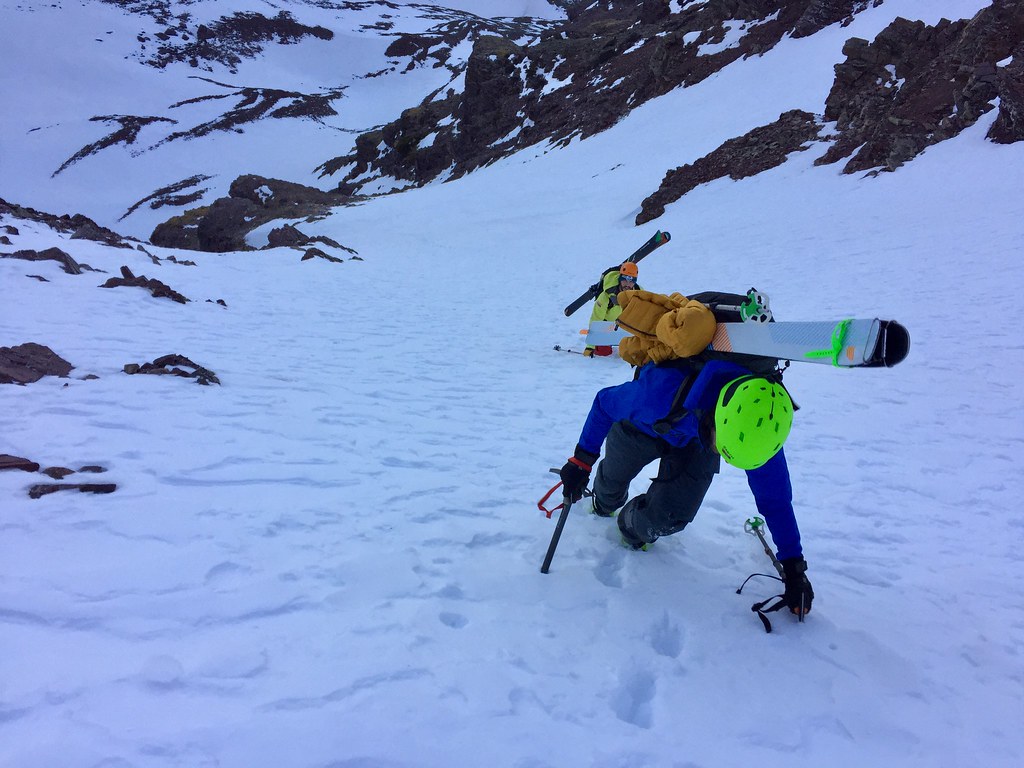
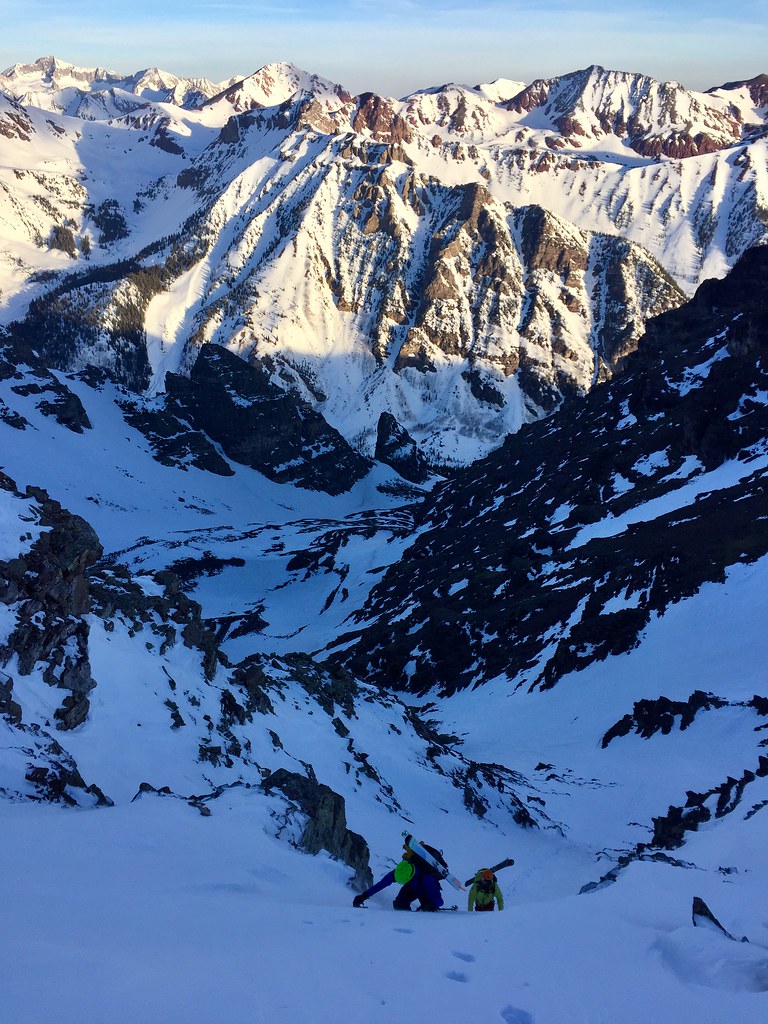
We topped out on the NE ridge at 13,100′ at 8am, just as the sun cleared some low clouds.
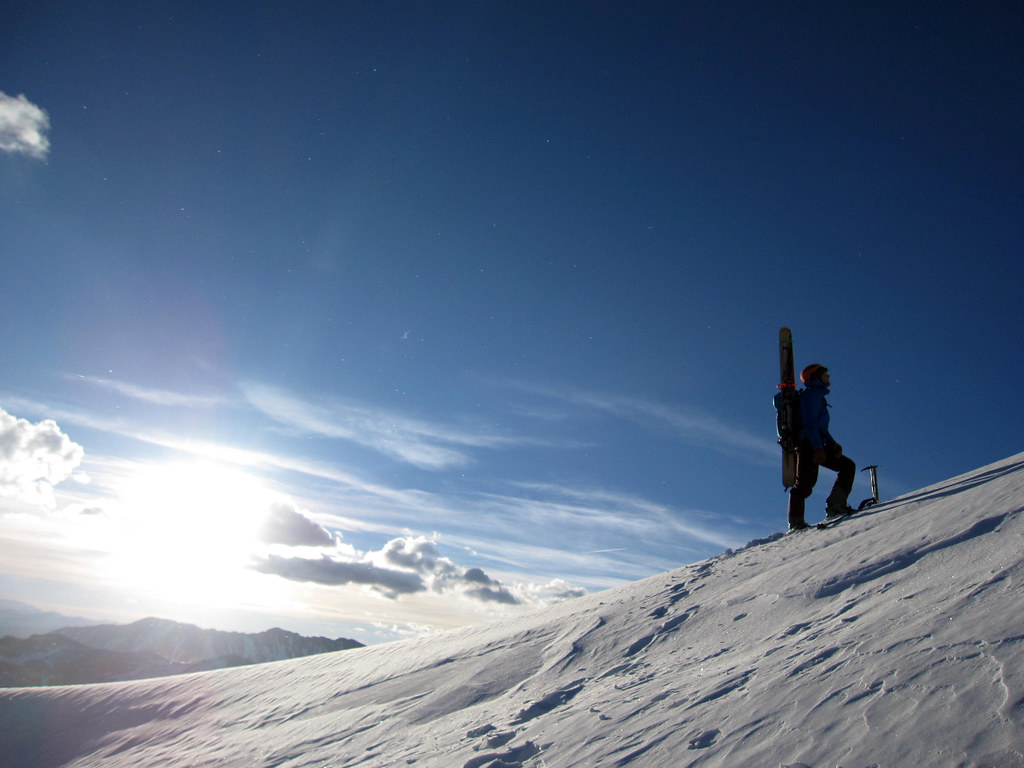
Photo by Jeff Welch.
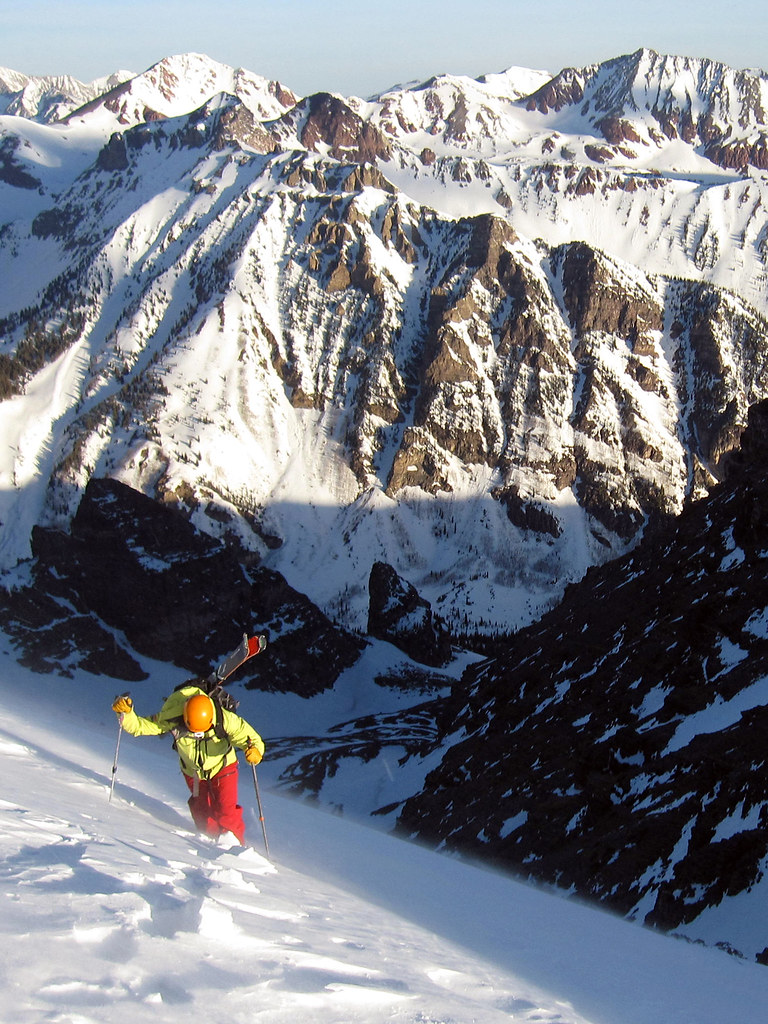
Photo by Jeff Welch.
And we got our first view of the east face and Landry Line, our intended descent route.
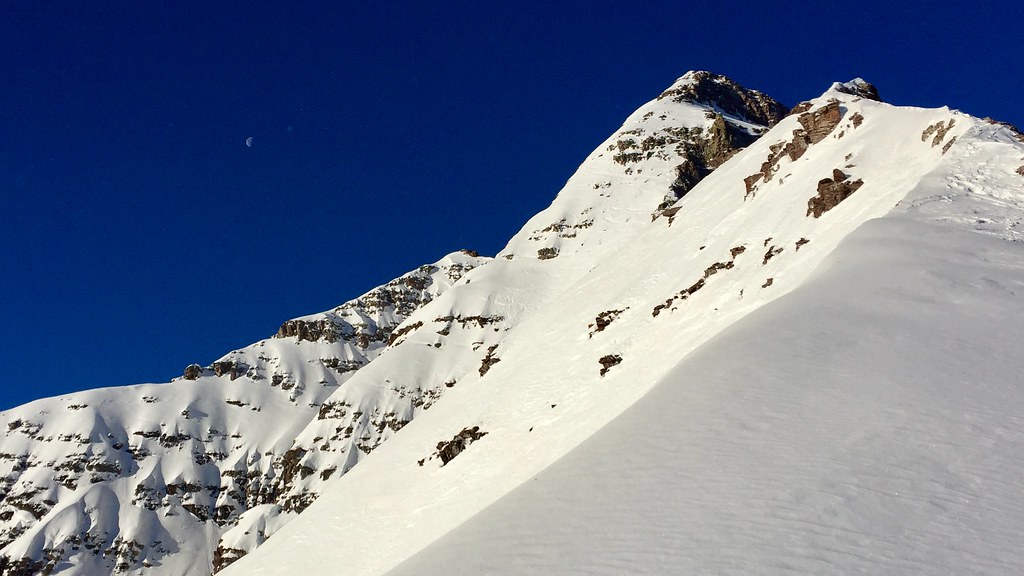
Hitting the ridge is the moment of truth. There is only one way off the summit on skis – descending east on 60° snow above an enormous cliff. If you fall anywhere between the summit and the point where we were standing, you go in the ground. That’s really all there is to it. There’s no real escape route – your only options are to downclimb what you came up (arguably more dangerous than just skiing it) or downclimb the NW ridge, where routefinding is tricky especially since it’s not the route you came up. Once you begin the final push to the summit, you are committed.
We paused. Rehydrated. Ate. And discussed. Pictures of the upper east face do not do justice to what it looks like when you’re staring at it. Emotions ranged from intimidated to terrified. Everything looks steeper when you view it head on, but it looked fucking vertical. And perhaps more importantly, it looked very frozen, and the wind was still howling. No matter how much sun is beating down, wind is remarkably good at keeping snow surfaces cold, especially this early in the year before the sun angle gets too high.
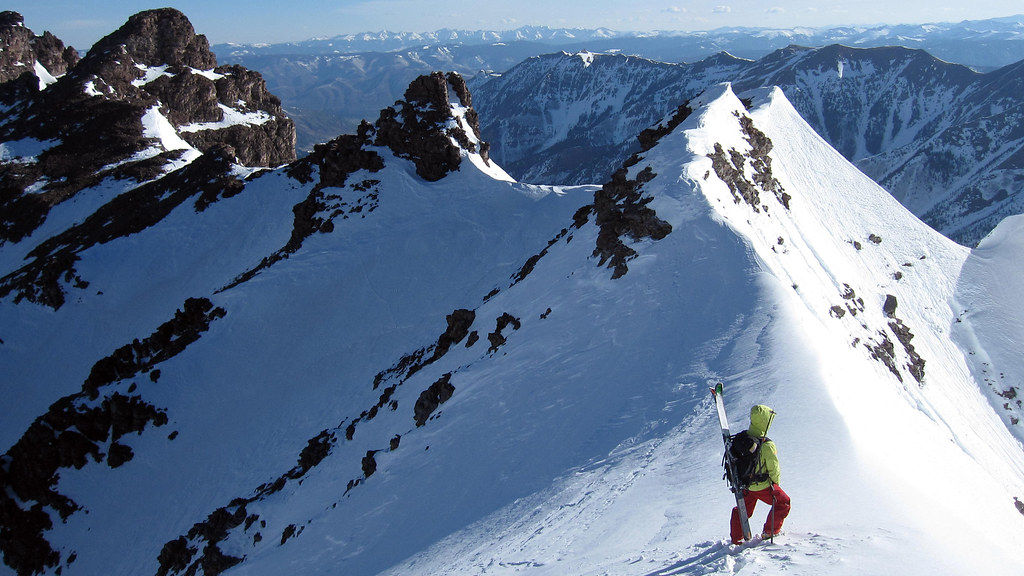
Photo by Jeff Welch.
We decided we really needed to know what the quality of the east facing snow was like. Was it as frozen as it looked? Was it chalky? Icy? Beginning to corn up? Unfortunately our spot on the ridge was guarded by a cornice, but 100′ higher it appeared we could access a small patch of representative snow. We cramponed up the narrowing knife edge ridge, making a difficult move in rotten snow between a rock band and a strange, man-swallowing hole in the snow to reach our evaluation point.
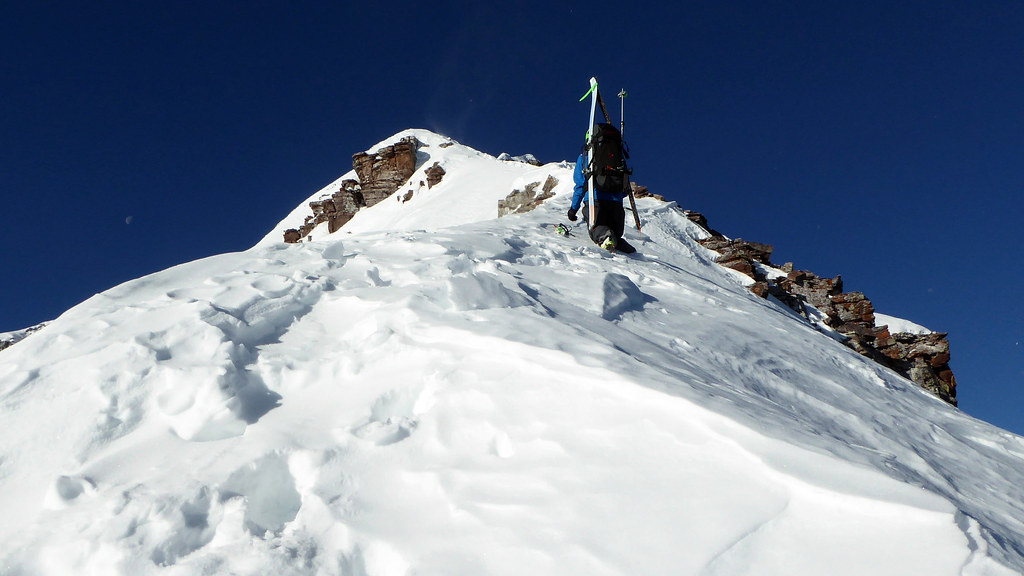
Reaching a good spot, Rick reached out with a pole basket, and the results were discouraging.
“Bulletproof,” Rick announced.
So we discussed. And discussed. It took us an hour to reach our eventual group decision. Today was not the day.
It really came down to the wind. Without the wind, the face probably would have softened up enough. We had no way to know what would happen, or when. The forecast was for consistent winds throughout the day, but it seemed to be slowly letting up. The issue was, the Landry Line is over 4,300 vertical feet to the valley floor, and the majority of it is steep enough to slide, especially when wet avalanche problems (particularly wet slab) are on the problem list. If the wind let up, the upper face would soften enough to safely ski, but at what time? 10am? 11? Noon or later? The lower 2/3 of the line were sheltered from the wind, so we feared that by the time the upper face softened enough, the lower sections would be dangerously saturated.
I was the first one to pull the plug. On top of the weather uncertainty and snowpack concerns, I did not feel 100% mentally. I was a bit gripped thanks to exhaustion and not having spent much time in really steep, technical terrain this season. In fact I had only been on skis 3 days in the previous month, two relaxed days at Loveland with my girlfriend, and one day skiing the very moderate Cristo Couloir on Quandary. The vertical world I suddenly found myself in had me feeling out of sorts. Mentally, I wasn’t there. On a slightly less demanding line, I could have safely pushed through, but the Landry Line is not one to do when you’re not feeling it. As an engineer, I tend to guide myself on fact and logical reasoning as much as possible, but sometimes it is important to let the primal instincts take over.
I told Rick and Ben I was out, but that I was 100% comfortable skiing back down our ascent route solo if they wanted to continue. We continued to discuss, with Rick leaning more towards bailing and Ben wanting to make sure he considered every possible route to success before calling it. Ultimately we all knew the best decision was retreat. While I could tell that my partners were a bit disappointed – not by me, but by the fact that things didn’t quite line up – I knew we had made the correct call. Even if we could have gotten away with it, we made the correct call because our choice led to certain survival. That choice is never the wrong decision.

Photo by Jeff Welch.
We downclimbed 100ft back to the platform on the ridge and transitioned. Our “consolation prize” descent was not so consoling. Though not the Landry line, the terrain was great – 3,000′ of steep, aesthetic terrain with stunning scenery. Unfortunately it all faces west, and we were skiing it many hours before it would see sunlight and begin to soften up. It was mostly chattery, unpleasant, and loud.
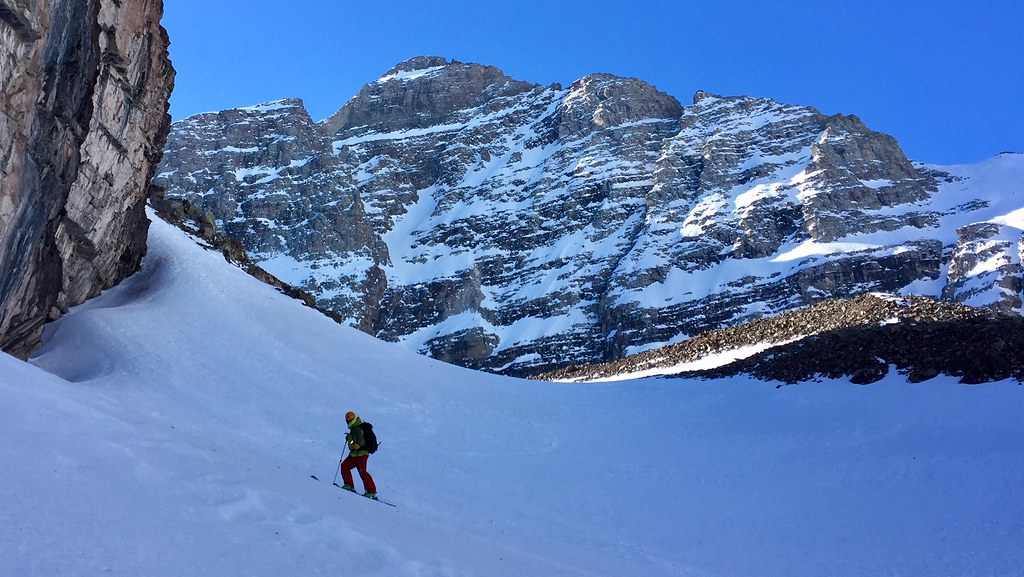
Back down at the lake, the weather was hot. Sledding up in the dark we hadn’t gotten to see the famed vista the Maroon Bells offers. It’s probably the most touristy mountain view in Colorado, but it really is spectacular, even more so in the winter than in the summer. Rick and I shuttled down to recover our other sled, then enjoyed the warmth, a beer, and the view before packing up and heading down.
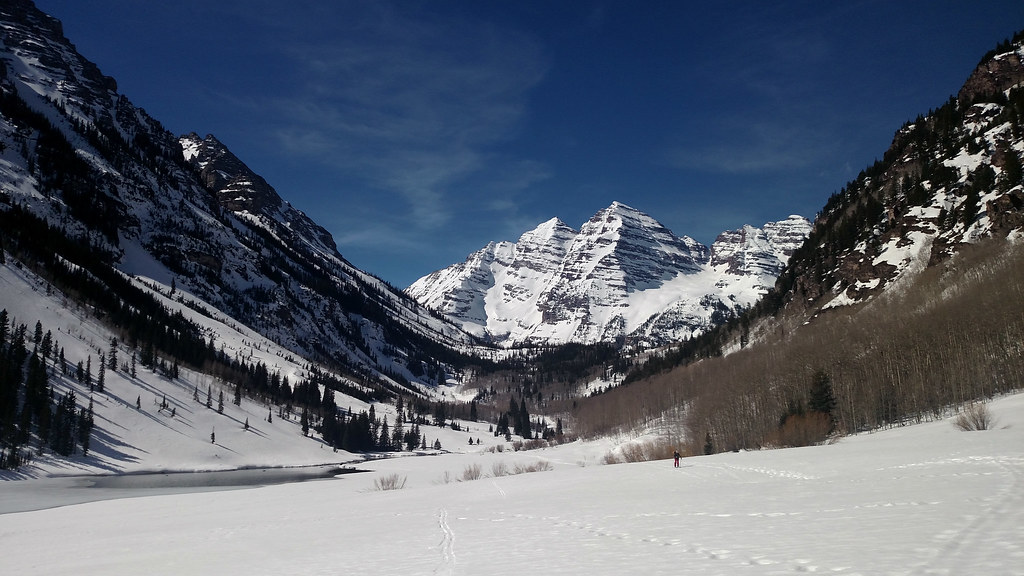
Photo by Jeff Welch.
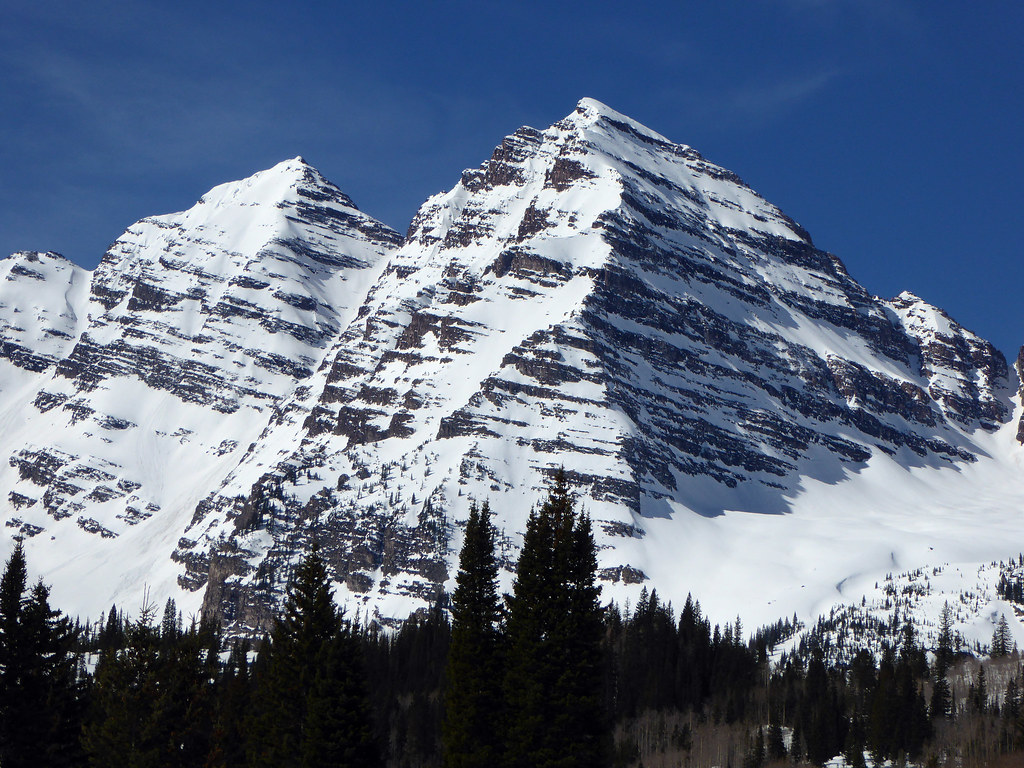
Unfortunately our trials and tribulations were not over yet. As I started up my sled, I glanced down at the fuel gauge, which was hovering just above “E.” That was weird… I had started with a nearly full tank, and had only driven about 18 miles including shuttling back and forth, which shouldn’t have used nearly that much fuel. I had noticed a strange fuel spill between the hood and dash earlier, as well as a bit more smoke than normal coming off the silencer. Opening the hood to take a look revealed a dejecting sight – fuel everywhere, on the side of the engine, on the pipe, sprayed across the bulkhead and the silencer. I figured out it was coming from somewhere in the main fuel supply line, perhaps near one of the fittings. No spare line, not much else we could do, so I fired it up and took off, hoping I had just enough fuel to make it to the parking lot.
No such luck. About 1.5mi from the bottom, the sled sputtered and died. But I knew I was close, so I freed my skis from the rack and skated, poled, and skied down the remaining road to the truck while Rick and Ben drove the other sled down. I drove into town to buy a fuel can and a couple more gallons of gas, leaving Rick and Ben in the parking lot to explain to confused tourists that it is, in fact, not possible to drive to the Maroon Bells in the winter, and that yes it really is 6 miles to get up there, and yes they are completely sure the road is totally snow covered, that’s why we drove a snowmobile.
Apparently it’s impossible to buy a fuel jug in Aspen larger than 1 gallon and apparently three 1-gal fuel cans will run you the better part of a $50 bill. Still, it would do, so Rick and I brapped back up to refill and recover my sled. We found the leak where the fuel supply line had contacted the exhaust pipe, redneck patched it with some medical tape and a couple zip ties to staunch the bleeding somewhat, and successfully limped the sled home.
Overall it was a surprisingly eventful day, disappointing that we couldn’t ski our line, but glad to have listened when the mountain said no and to have spent a day in amazing mountains with great people. Huge thanks to Rick and Ben for being great partners, and to Colin for the use of his sled. We’ll be back.


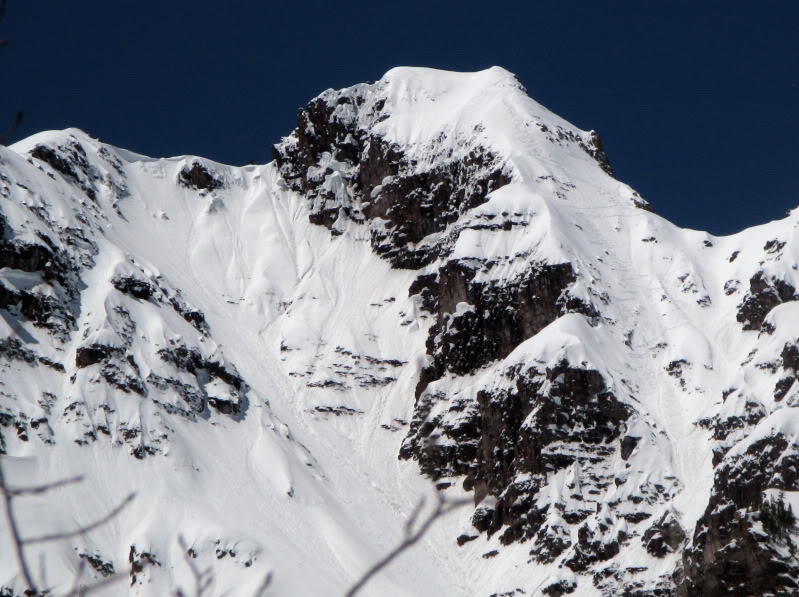
Very nice TR, Jeff. So sorry the attempt didn’t work out, but you guys made the right call. I think 10am or even later would have been primo to ski it based on the previous day’s weather and sun exposure. it’ll always be there! get back this spring!
Loved this report. Was looking forward to an account of this. The moral I’m taking from the story is to get that extra hour of sleep! Superb pictures and a great write up, Jeff.